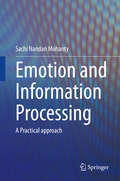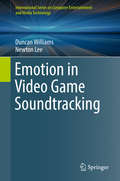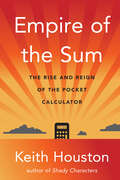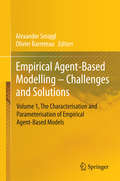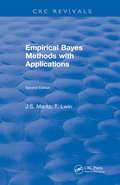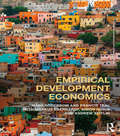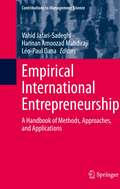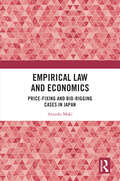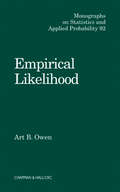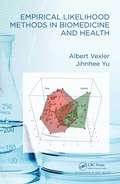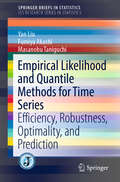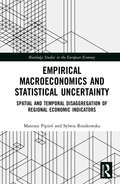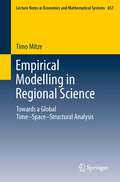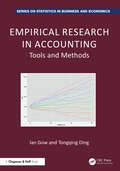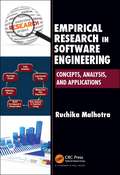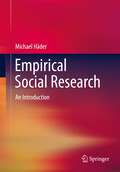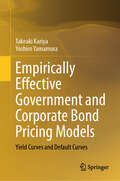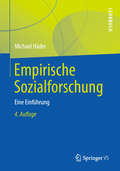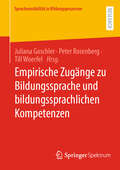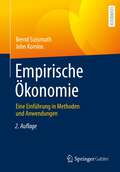- Table View
- List View
Emotion and Information Processing: A Practical approach
by Sachi Nandan MohantyThis book consists of thirteen chapters covering many facts like psycho-social intervention on emotional disorders in individuals, impact of emotion and cognition on blended theory, theory and implication of information processing, effects of emotional self esteem in women, emotional dimension of women in workplace, effects of mental thinking in different age groups irrespective of the gender, negative emotions and its effect on information processing, role of emotions in education and lastly emotional analysis in multi perspective domain adopting machine learning approach. Most of the chapters having experimental studies, with each experiment having different constructs as well as different samples for each data collection. Most of the studies measure information processing within altered mood states, such as depression, anxiety, or positive emotional states, with mental ability tasks being conducted in addition to the experiments of quasi-experimental design.
Emotion in Video Game Soundtracking
by Newton Lee Duncan WilliamsThis book presents an overview of the emerging field of emotion in videogame soundtracking. The emotional impact of music has been well-documented, particularly when used to enhance the impact of a multimodal experience, such as combining images with audio as found in the videogames industry. Soundtracking videogames presents a unique challenge compared to traditional composition (for example film music) in that the narrative of gameplay is non-linear – Player dependent actions can change the narrative and thus the emotional characteristics required in the soundtrack. Historical approaches to emotion measurement, and the musical feature mapping and music selection that might be used in video game soundtracking are outlined, before a series of cutting edge examples are given. These examples include algorithmic composition techniques, automated emotion matching from biosensors, motion capture techniques, emotionally-targeted speech synthesis and signal processing, and automated repurposing of existing music (for example from a players own library). The book concludes with some possibilities for the future.
Emotional Intelligence: Second CSIG Conference, CEI 2024, Nanjing, China, December 6-8, 2024, Proceedings (Communications in Computer and Information Science #2450)
by Xiaohua Huang Qirong MaoThis book constitutes the proceedings of the Second CSIG Conference on Emotional Intelligence, CEI 2024, held in Nanjing, China during December 6-8, 2024. The 14 full papers and 2 short papers presented in this volume were carefully reviewed and selected from 41 submissions. These papers have been categorized under the following topical sections: Emotional Intelligence Surveys and Databases; Emotional Intelligence Methods; Emotional Intelligence Applications.
Empire of the Sum: The Rise And Reign Of The Pocket Calculator
by Keith HoustonA New York Times Book Review Editors' Choice The hidden history of the pocket calculator—a device that ushered in modern mathematics, helped build the atomic bomb, and went with us to the moon—and the mathematicians, designers, and inventors who brought it to life. Starting with hands, abacus, and slide rule, humans have always reached for tools to simplify math. Pocket-sized calculators ushered in modern mathematics, helped build the atomic bomb, took us to the bottom of the ocean, and accompanied us to the moon. The pocket calculator changed our world, until it was supplanted by more modern devices that, in a cruel twist of irony, it helped to create. The calculator is dead; long live the calculator. In this witty mathematic and social history, Keith Houston transports readers from the nascent economies of the ancient world to World War II, where a Jewish engineer calculated for his life at Buchenwald, and into the technological arms race that led to the first affordable electronic pocket calculators. At every turn, Houston is a scholarly, affable guide to this global history of invention. Empire of the Sum will appeal to math lovers, history buffs, and anyone seeking to understand our trajectory to the computer age.
Empirical Agent-Based Modelling - Challenges and Solutions
by Alexander Smajgl Olivier BarreteauThis instructional book showcases techniques to parameterise human agents in empirical agent-based models (ABM). In doing so, it provides a timely overview of key ABM methodologies and the most innovative approaches through a variety of empirical applications It features cutting-edge research from leading academics and practitioners, and will provide a guide for characterising and parameterising human agents in empirical ABM In order to facilitate learning, this text shares the valuable experiences of other modellers in particular modelling situations. Very little has been published in the area of empirical ABM, and this contributed volume will appeal to graduate-level students and researchers studying simulation modeling in economics, sociology, ecology, and trans-disciplinary studies, such as topics related to sustainability. In a similar vein to the instruction found in a cookbook, this text provides the empirical modeller with a set of 'recipes' ready to be implemented. Agent-based modeling (ABM) is a powerful, simulation-modeling technique that has seen a dramatic increase in real-world applications in recent years In ABM, a system is modeled as a collection of autonomous decision-making entities called "agents. " Each agent individually assesses its situation and makes decisions on the basis of a set of rules. Agents may execute various behaviors appropriate for the system they represent--for example, producing, consuming, or selling ABM is increasingly used for simulating real-world systems, such as natural resource use, transportation, public health, and conflict Decision makers increasingly demand support that covers a multitude of indicators that can be effectively addressed using ABM. This is especially the case in situations where human behavior is identified as a critical element. As a result, ABM will only continue its rapid growth. This is the first volume in a series of books that aims to contribute to a cultural change in the community of empirical agent-based modelling. This series will bring together representational experiences and solutions in empirical agent-based modelling. Creating a platform to exchange such experiences allows comparison of solutions and facilitates learning in the empirical agent-based modelling community. Ultimately, the community requires such exchange and learning to test approaches and, thereby, to develop a robust set of techniques within the domain of empirical agent-based modelling. Based on robust and defendable methods, agent-based modelling will become a critical tool for research agencies, decision making and decision supporting agencies, and funding agencies. This series will contribute to more robust and defendable empirical agent-based modelling.
Empirical Bayes Methods with Applications (Routledge Library Editions: Econometrics Ser. #12)
by J.S. MaritzThe second edition of Empirical Bayes Methods details are provided of the derivation and the performance of empirical Bayes rules for a variety of special models. Attention is given to the problem of assessing the goodness of an empirical Bayes estimator for a given set of prior data. A chapter is devoted to a discussion of alternatives to the empirical Bayes approach and there is also a chapter giving details of several actual applications of empirical Bayes method.
Empirical Development Economics (Routledge Advanced Texts in Economics and Finance)
by Simon Quinn Måns Söderbom Francis Teal Markus Eberhardt Andrew ZeitlinUnderstanding why so many people across the world are so poor is one of the central intellectual challenges of our time. This book provides the tools and data that will enable students, researchers and professionals to address that issue. Empirical Development Economics has been designed as a hands-on teaching tool to investigate the causes of poverty. The book begins by introducing the quantitative approach to development economics. Each section uses data to illustrate key policy issues. Part One focuses on the basics of understanding the role of education, technology and institutions in determining why incomes differ so much across individuals and countries. In Part Two, the focus is on techniques to address a number of topics in development, including how firms invest, how households decide how much to spend on their children’s education, whether microcredit helps the poor, whether food aid works, who gets private schooling and whether property rights enhance investment. A distinctive feature of the book is its presentation of a range of approaches to studying development questions. Development economics has undergone a major change in focus over the last decade with the rise of experimental methods to address development issues; this book shows how these methods relate to more traditional ones. Please visit the book's website at www.empiricalde.com for online supplements including Stata files and solutions to the exercises.
Empirical Evidence on the Efficiency of Forward and Futures Foreign Exchange Markets (Fundamentals Of Pure And Applied Economics Ser.)
by Robert J. HodrickThis book presents a critical review of the empirical literature that studies the efficiency of the forward and futures markets for foreign exchange. It provides a useful foundation for research in developing quantitative measures of risk and expected return in international finance.
Empirical International Entrepreneurship: A Handbook of Methods, Approaches, and Applications (Contributions to Management Science)
by Léo-Paul Dana Vahid Jafari-Sadeghi Hannan Amoozad MahdirajiThis handbook is focused on the analytical dimension in researching international entrepreneurship. It offers a diverse collection of chapters focused on qualitative and quantitative methods that are being practised and can be used by future researchers in the field of international entrepreneurship. The qualitative cluster covers articles, conceptual and empirical chapters as well as literature reviews, whereas the quantitative cluster analyses international entrepreneurship through a broad range of statistical methods such as regressions, panel data, structural equation modelling as well as decision-making and optimisation models in certain and uncertain circumstances. This book is essential reading for researchers, scholars and practitioners who want to learn and implement new methods in analysing entrepreneurial opportunities across national borders.
Empirical Investigations of Social Space (Methodos Series #15)
by Jörg Blasius Andreas Schmitz Frédéric Lebaron Brigitte Le RouxThis book provides an in-depth view on Bourdieu’s empirical work, thereby specially focusing on the construction of the social space and including the concept of the habitus. Themes described in the book include amongst others: • the theory and methodology for the construction of “social spaces”, • the relation between various “fields” and “the field of power”, • formal construction and empirical observation of habitus, • the formation, accumulation, differentiation of and conversion between different forms of capital, • relations in geometric data analysis.The book also includes contributions regarding particular applications of Bourdieu’s methodology to traditional and new areas of research, such as the analysis of institutional, international and transnational fields. It further provides a systematic introduction into the empirical construction of the social space.
Empirical Law and Economics: Price-Fixing and Bid-Rigging Cases in Japan
by Atsushi MakiMaki provides an empirical analysis of law and economics by reevaluating Myrdal's value premises and Weber's separation of analysis and policy.In modern civil society, individuals and businesses conduct economic activities through markets. The mainstream economic theory is the general equilibrium theory, which assumes a perfectly competitive market. The upshot is that transactions through competitive markets maximize the economic welfare of society, with policies such as deregulation and privatization being implemented with the backing of the law. However, in the real economy, legal transactions do not always take place, and this book analyzes price-fixing and bid-rigging cases. These cases show that there is a gap between competition philosophy and legislation. Using the real economy as data, this book conducts an empirical analysis of law and economics and illustrates issues related to the ideals of economics and the proper application of law. Accumulating empirical results will provide the means to form a healthy civil society.A useful reference for graduate students and researchers in economics and legal research, and an interesting read for those who consider economics to be an empirical science.
Empirical Likelihood (Chapman & Hall/CRC Monographs on Statistics and Applied Probability)
by Art B. OwenEmpirical likelihood provides inferences whose validity does not depend on specifying a parametric model for the data. Because it uses a likelihood, the method has certain inherent advantages over resampling methods: it uses the data to determine the shape of the confidence regions, and it makes it easy to combined data from multiple sources. It al
Empirical Likelihood Method in Survival Analysis
by Mai ZhouEmpirical Likelihood Method in Survival Analysis explains how to use the empirical likelihood method for right censored survival data. The author uses R for calculating empirical likelihood and includes many worked out examples with the associated R code. The datasets and code are available for download on his website and CRAN.The book focuses on all the standard survival analysis topics treated with empirical likelihood, including hazard functions, cumulative distribution functions, analysis of the Cox model, and computation of empirical likelihood for censored data. It also covers semi-parametric accelerated failure time models, the optimality of confidence regions derived from empirical likelihood or plug-in empirical likelihood ratio tests, and several empirical likelihood confidence band results.While survival analysis is a classic area of statistical study, the empirical likelihood methodology has only recently been developed. Until now, just one book was available on empirical likelihood and most statistical software did not include empirical likelihood procedures. Addressing this shortfall, this book provides the functions to calculate the empirical likelihood ratio in survival analysis as well as functions related to the empirical likelihood analysis of the Cox regression model and other hazard regression models.
Empirical Likelihood Methods in Biomedicine and Health
by Albert Vexler Jihnhee YuEmpirical Likelihood Methods in Biomedicine and Health provides a compendium of nonparametric likelihood statistical techniques in the perspective of health research applications. It includes detailed descriptions of the theoretical underpinnings of recently developed empirical likelihood-based methods. The emphasis throughout is on the application of the methods to the health sciences, with worked examples using real data. Provides a systematic overview of novel empirical likelihood techniques. Presents a good balance of theory, methods, and applications. Features detailed worked examples to illustrate the application of the methods. Includes R code for implementation. The book material is attractive and easily understandable to scientists who are new to the research area and may attract statisticians interested in learning more about advanced nonparametric topics including various modern empirical likelihood methods. The book can be used by graduate students majoring in biostatistics, or in a related field, particularly for those who are interested in nonparametric methods with direct applications in Biomedicine.
Empirical Likelihood and Quantile Methods for Time Series: Efficiency, Robustness, Optimality, and Prediction (SpringerBriefs in Statistics)
by Yan Liu Masanobu Taniguchi Fumiya AkashiThis book integrates the fundamentals of asymptotic theory of statistical inference for time series under nonstandard settings, e.g., infinite variance processes, not only from the point of view of efficiency but also from that of robustness and optimality by minimizing prediction error. This is the first book to consider the generalized empirical likelihood applied to time series models in frequency domain and also the estimation motivated by minimizing quantile prediction error without assumption of true model. It provides the reader with a new horizon for understanding the prediction problem that occurs in time series modeling and a contemporary approach of hypothesis testing by the generalized empirical likelihood method. Nonparametric aspects of the methods proposed in this book also satisfactorily address economic and financial problems without imposing redundantly strong restrictions on the model, which has been true until now. Dealing with infinite variance processes makes analysis of economic and financial data more accurate under the existing results from the demonstrative research. The scope of applications, however, is expected to apply to much broader academic fields. The methods are also sufficiently flexible in that they represent an advanced and unified development of prediction form including multiple-point extrapolation, interpolation, and other incomplete past forecastings. Consequently, they lead readers to a good combination of efficient and robust estimate and test, and discriminate pivotal quantities contained in realistic time series models.
Empirical Macroeconomics and Statistical Uncertainty: Spatial and Temporal Disaggregation of Regional Economic Indicators (Routledge Studies in the European Economy)
by Mateusz Pipień Sylwia RoszkowskaThis book addresses one of the most important research activities in empirical macroeconomics. It provides a course of advanced but intuitive methods and tools enabling the spatial and temporal disaggregation of basic macroeconomic variables and the assessment of the statistical uncertainty of the outcomes of disaggregation. The empirical analysis focuses mainly on GDP and its growth in the context of Poland. However, all of the methods discussed can be easily applied to other countries. The approach used in the book views spatial and temporal disaggregation as a special case of the estimation of missing observations (a topic on missing data analysis). The book presents an econometric course of models of Seemingly Unrelated Regression Equations (SURE). The main advantage of using the SURE specification is to tackle the presented research problem so that it allows for the heterogeneity of the parameters describing relations between macroeconomic indicators. The book contains model specification, as well as descriptions of stochastic assumptions and resulting procedures of estimation and testing. The method also addresses uncertainty in the estimates produced. All of the necessary tests and assumptions are presented in detail. The results are designed to serve as a source of invaluable information making regional analyses more convenient and – more importantly – comparable. It will create a solid basis for making conclusions and recommendations concerning regional economic policy in Poland, particularly regarding the assessment of the economic situation. This is essential reading for academics, researchers, and economists with regional analysis as their field of expertise, as well as central bankers and policymakers.
Empirical Modelling in Regional Science
by Timo MitzeEconomic agents interact in structural relationships through time and space. This work starts from the empirical observation that all three dimensions, namely time, space, and structural functional forms, are important for an integrative framework of modern empirical analysis in regional science. The work thus aims at combining up-to-date econometric tools from the fields of spatial econometrics, panel time-series analysis and structural simultaneous equation modelling to analysis the different research questions at hand. Most of the topics dealt within this work start from a concrete empirical problem, while problem solving also aims at generating some new knowledge in a methodological way, e.g. by the complementary use of Monte Carlo simulation studies to compare the empirical performance of different estimators for specific data samples. Following a first introductory chapter, the work is structured in three parts addressing major issues in building up a stylized regional economic model such as interregional migration, factor and final demand estimation. All empirical applications use German regional data.
Empirical Research in Accounting: Tools and Methods (Chapman and Hall/CRC Series on Statistics in Business and Economics)
by Ian D. Gow Tongqing DingThis textbook provides the foundation for a course that takes PhD students in empirical accounting research from the very basics of statistics, data analysis, and causal inference up to the point at which they conduct their own research. Starting with foundations in statistics, econometrics, causal inference, and institutional knowledge of accounting and finance, the book moves on to an in-depth coverage of the core papers in capital market research. The latter half of the book examines contemporary approaches to research design and empirical analysis, including natural experiments, instrumental variables, fixed effects, difference-in-differences, regression discontinuity design, propensity-score matching, and machine learning. Readers of the book will develop deep data analysis skills using modern tools. Extensive replication and simulation analysis is included throughout.Key Features: Extensive coverage of empirical accounting research over more than 50 years. Integrated coverage of statistics and econometrics, institutional knowledge, and research design. Numerous replications and a dozen simulation analyses to immerse readers in papers and empirical analysis. All tables and figures in the book can be reproduced by readers using included code. Easy-to-use templates facilitate hands-on exercises and introduce reproduceable research concepts. (Solutions available to instructors.)
Empirical Research in Software Engineering: Concepts, Analysis, and Applications
by Ruchika MalhotraEmpirical research has now become an essential component of software engineering yet software practitioners and researchers often lack an understanding of how the empirical procedures and practices are applied in the field. Empirical Research in Software Engineering: Concepts, Analysis, and Applications shows how to implement empirical research pro
Empirical Social Research: An Introduction
by Michael HäderSocial science methods such as surveys, observations and content analyses are used in market research, studies of contemporary history, urban planning and communication research. They are all the more needed by sociologists and empirically working political scientists. Whether in the context of evaluating a prevention programme or for surveying health behaviour or for a study on social mobility, the confident handling of the social science instruments is always a prerequisite for obtaining reliable results. This book provides important information for users and developers of these instruments. It deals with the theoretical foundations of the methods, the steps in the conception and implementation of a project, the many variants of data collection, the methods to be used in the selection of study units, as well as the principles to be observed in the evaluation and documentation of the findings. With the help of numerous examples, a particularly clear presentation is achieved. In the fourth, updated edition, river sampling has now been included in the selection process, digital methods are increasingly presented and, against the background of the new data protection regulation, research ethics and data protection are also updated.
Empirically Effective Government and Corporate Bond Pricing Models: Yield Curves and Default Curves
by Takeaki Kariya Yoshiro YamamuraThis book presents a comprehensive, innovative, integrated, and empirically effective system for cross-sectionally analyzing prices of government bonds (GBs) and corporate bonds (CBs) to timely obtain practically useful information on yield curves and default curves. The system consists of (1) GB-pricing model that values coupon GB and gives yield curve, (2) credit risk rating model of each CB, and (3) CB-pricing model that gives default curve or equivalently term structure of default probabilities (TSDP), which prices credit default swap (CDS). And in view of data science, the empirical effectiveness of the modeling concept, formulated models with price correlations, and estimation procedures in the system is verified with monthly data through various applications of the models to practically important analyses on prices of Japanese GBs and CBs, the USA GBs and CBs, and European GBs (EUGBs) where GBs of Germany, France, Italy, Spain, and Greece. Fact, both yield curves and default curves over a future time horizon. The system enables us to get practically and timely predictive information for making decisions in investment, formation of effective bond portfolio, asset and liability management (ALM), and risk management of yield curve and default curve in banks, trust funds, pension funds, life insurance firms, among others.
Empirische Sozialforschung: Eine Einführung
by Michael HäderSozialwissenschaftliche Methoden wie Befragungen, Beobachtungen und Inhaltsanalysen kommen in der Marktforschung, bei Studien zur Zeitgeschichte, in der Stadtplanung und in der Kommunikationsforschung zum Einsatz. Erst recht werden sie von Soziologen und empirisch arbeitenden Politikwissenschaftlern benötigt. Egal, ob im Rahmen der Evaluation eines Präventionsprogramms oder für die Erhebung des Gesundheitsverhaltens oder für eine Studie zur sozialen Mobilität, die sichere Handhabung des sozialwissenschaftlichen Instrumentariums ist stets die Voraussetzung, um belastbare Ergebnisse zu erzielen. Das Buch stellt wichtige Informationen für die Anwender und Entwickler dieser Instrumente zur Verfügung. Es behandelt die theoretischen Grundlagen der Methoden, die Schritte bei der Konzipierung und Umsetzung eines Projekts, die vielfältigen Varianten der Datenerhebung, die bei der Auswahl der Untersuchungseinheiten einzusetzenden Methoden ebenso wie die Prinzipien, die bei der Auswertung und Dokumentation der Befunde zu beachten sind. Mithilfe zahlreicher Beispiele gelingt eine besonders anschauliche Darstellung.In der vierten, aktualisierten Auflage hat im Rahmen der Auswahlverfahren nun auch das River Sampling Eingang gefunden, werden verstärkt auch digitale Methoden vorgestellt sowie vor dem Hintergrund der neuen Datenschutzverordnung auch die Forschungsethik und der Datenschutz aktualisiert.
Empirische Zugänge zu Bildungssprache und bildungssprachlichen Kompetenzen (Sprachsensibilität in Bildungsprozessen)
by Juliana Goschler Peter Rosenberg Till WoerfelIn der Diskussion über Sprache in Bildungskontexten geht man davon aus, dass diese sogenannte „Bildungssprache“ durch verschiedene grammatische und lexikalische Merkmale charakterisiert wird. Häufig wird außerdem angenommen, dass diese Merkmale für Schüler/-innen – unter anderem und insbesondere solchen, die Deutsch als Zweitsprache erlernen – schwierig und damit eine Hürde für erfolgreiches fachliches Lernen sein könnten. Der Band widmet sich in einer Reihe von Einzelstudien möglichen Zugängen zur empirischen Überprüfung dieser Annahmen.
Empirische Ökonomie
by Bernd Süssmuth John KomlosDas Buch führt anhand einfacher und zugleich origineller Anwendungen aus Gebieten wie Wirtschaftsgeschichte, Humankapitaltheorie oder Biologie in die Methoden der klassischen Ökonometrie ein. Da auch grundlegende Konzepte der beschreibenden und schließenden Statistik behandelt werden, sind keine Vorkenntnisse nötig. Damit stellt sich das Buch der Aufgabe, den Studierenden neben den methodischen Fertigkeiten auch Anregung und Motivation zu eigenständigem empirischen Arbeiten zu geben.
Empirische Ökonomie: Eine Einführung in Methoden und Anwendungen (Springer-lehrbuch Ser.)
by Bernd Süssmuth John KomlosDas Buch liefert eine anwendungsorientierte Einführung in ökonometrische Methoden. Anhand einfacher, aber origineller Anwendungen aus verschiedenen Gebieten wie Wirtschaftsgeschichte, Humankapitaltheorie oder Biologie werden die Methoden der klassischen Ökonometrie erklärt und veranschaulicht. Auf diese Art und Weise werden nicht nur methodische Fertigkeiten vermittelt, sondern Studierende zum eigenständigen empirischen Arbeiten motiviert. Fachkenntnisse werden nicht vorausgesetzt. Die 2. Auflage wurde um ein zusätzliches Kapitel ergänzt.
